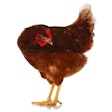
As the peak of the past year’s highly pathogenic avian influenza (HPAI) outbreaks in South Africa appears to have passed, the poultry sector is seeking greater resilience against a repetition of past devastation. Meanwhile, one new outbreak on a poultry farm has been reported in Niger.
Continuing the nation’s recent trend of declining disease frequency, the South African veterinary authority has officially confirmed just one further outbreak of HPAI in poultry over the past four weeks.
Even that was reported retrospectively to the World Organisation for Animal Health (WOAH), having started in August of 2023. Affected was a flock of 2,800 poultry at a farm in Mogale city in Gauteng. After around 600 of the birds died, the HPAI virus serotype responsible was identified as H7N6.
This brought to 116 the number of outbreaks in South African poultry infected with this virus variant since May of last year, based on WOAH notifications. Directly impacted have been around 11.2 million birds.
Furthermore, the H5N1 virus serotype has been confirmed at 28 locations in South Africa since mid-April of 2023, impacting almost 1.8 million poultry.
No new cases linked to either variant have been detected in commercial birds since January this year, according to this source.
At the end of February, one wild bird found in Western Cape tested positive for an avian flu virus of the H5 family.
Of the H7N6, 73 occurred in Gauteng, according to the government’s agriculture department, DALRR. Other cases were detected in seven other provinces, making Northern Cape the only area without cases linked to this serotype. More than half of the outbreaks involved laying hens, and 17 affected broiler breeders.
For H5N1, 19 of the 28 outbreaks reported affected premises in Western Cape, including all 12 of the country’s impacted commercial ostrich flocks, and seven of its nine outbreaks in laying hens.
In the current issue of Poultry Bulletin, the South African Poultry Association (SAPA) highlights that the mortality rate resulting from the H7 virus strain has been significantly higher than for H5. While H5N1 virus serotypes have been detected widely across the globe in recent years, it states that H7N6 has been unique to South Africa.
South Africa poultry industry pushes for vaccination, compensation
Currently, authorization to vaccinate poultry against HPAI in South Africa are “onerous,” according to SAPA in the same publication. It says that the conditions set by the DALRRD in November last year are so high that millions of birds will be left unprotected from future losses resulting from HPAI.
While the largest broiler breeder farms would likely qualify for authorization to vaccinate, even mid-sized laying flocks would not, it says. Furthermore, SAPA adds, biosecurity and monitoring requirements are so high that few will qualify.
SAPA reports it is in discussion with the authorities to allow more of the country’s poultry owners to be authorized to vaccinate their flocks.
Furthermore, the organization says it is also urging DALRR to set up a disaster fund. This would support livelihoods of the many poultry owners who were forced to cull their flocks due to HPAI, and have so far received no financial compensation from the state.
Avian flu developments in West Africa
Following the recent confirmation of a human infection with the influenza A(H5N1) virus variant in the United States, Nigeria is strengthening its vigilance for similar cases.
Head of the Nigerian Centre for Disease Control said the case in the U.S. is a worrying development, reported Business Day. To forestall a full public health crisis, he urged medical authorities to increase vigilance.
In the same article, a public health expert warned that influenza viruses can mutate rapidly, leading to the potential acceleration of spreading to and between people.
Nigeria became the first African country to report avian influenza in poultry in early 2006, and it confirmed the region’s first human case in the following year.
Since then, the source reports, six HPAI waves linked to the H5N1 virus serotype have hit the nation’s poultry sector, as well as outbreaks of H5N6 and H5N8.
Based on notifications to WOAH, Nigeria’s current H5N1 series began in December of 2020. Since then, outbreaks have been reported at 456 locations in 31 out of 37 administrative regions. Directly impacted have been just over 2.4 million poultry, most recently at the end of February this year.
In the adjacent Niger, presence of the same virus serotype was confirmed at a family farm in the capital, Niamey. According to Burkina24, this outbreak followed cases in 10 flocks in three regions — including Niamey — two years previously.
Meanwhile, Burkina Faso has been awarded support valued at 14 million francs (CFA; US$23,000) towards the costs of controlling HPAI. Funding came from the United Nations’ Food and Agriculture Organization (FAO), reports MSN, and comprised lab equipment and protective clothing.
Early in March, the H5N1 HPAI virus was detected in Burkina Faso for the first time following a brief hiatus.
HPAI reported 'resolved' in Mali
Earlier this month, the veterinary authority of the Republic of Mali in West Africa declared to WOAH that two HPAI outbreak series have been “resolved.”
These relate to separate disease series, both involving the H5N1 virus serotype and confined to Koulikoro. This southwestern region surrounds the capital city, Bamako.
Between April of 2021 and March of the following year, outbreaks were confirmed at three farms. Directly impacted were a total of almost 360,000 poultry.
View our continuing coverage of the global avian influenza situation.

















